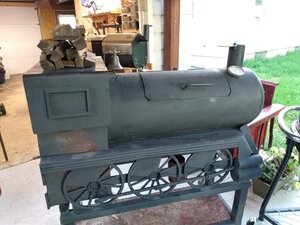- Aug 24, 2020
- 55
- 91
I have a feeling I will get some mixed answers with this one, but here goes.
I recently went with a friend to help him pick up a smoker that was custom built. The price was right, the build quality is good, and it was the size he needed for his small patio.
We did a test run on it and we were very, very impressed with how well it held temp, how clean the smoke was, just thin blue to almost invisible, and with how well the temperature responded to the vents.
So we put a pork but on, used hickory and cherry splits, charcoal only in the beginning to light the splits. It sat in a bath of light blue smoke for 8 hours until we had to wrap and then after wrapping it went on the pellet grill. When on the pellet grill, somehow the two layers of foil still managed to break and all the liquid leaked out.
The pork butt had a nice smoke ring, everything looked good, but when tasting there was little to no smoke flavor. If I hadn't witnessed it in the smoker I would have thought it was cooked in an oven.
I have 2 theories to what happened:
Either the splits we were using were too small or two dry and they did not produce enough smoke or turned to coals too quickly. Or that the fire was hot enough that on a smoker this size the hot air leaving was just that, hot air and no smoke, because it didn't have enough room to cool in the cook chamber.
Or theory number two is that smoke is attracted to moisture and when the juices leaked out of the wrap some of the smoky flavor got lost in the juice. This may be a stupid theory, but I'm left scratching my head.
To be fair I have an offset at home as well, and I usually get a bold smoke flavor on mine. Mine is a little bigger than his, and I usually struggle to burn as clean of a fire as he did, but I have never gotten what people describe as bitter smoke from my pit. My fire is never perfect and white smoke occasionally comes out but I try to do the best I can.
I'm hoping those with more experience can help out here. I was thinking our next step would be to try a little larger split to see if we can get a little longer burn before it turns to coals.
Also, we had a moisture meter and the splits were reading anywhere from 15-20% moisture, so I don't think the wood was over dried.
I'm stumped.
I recently went with a friend to help him pick up a smoker that was custom built. The price was right, the build quality is good, and it was the size he needed for his small patio.
We did a test run on it and we were very, very impressed with how well it held temp, how clean the smoke was, just thin blue to almost invisible, and with how well the temperature responded to the vents.
So we put a pork but on, used hickory and cherry splits, charcoal only in the beginning to light the splits. It sat in a bath of light blue smoke for 8 hours until we had to wrap and then after wrapping it went on the pellet grill. When on the pellet grill, somehow the two layers of foil still managed to break and all the liquid leaked out.
The pork butt had a nice smoke ring, everything looked good, but when tasting there was little to no smoke flavor. If I hadn't witnessed it in the smoker I would have thought it was cooked in an oven.
I have 2 theories to what happened:
Either the splits we were using were too small or two dry and they did not produce enough smoke or turned to coals too quickly. Or that the fire was hot enough that on a smoker this size the hot air leaving was just that, hot air and no smoke, because it didn't have enough room to cool in the cook chamber.
Or theory number two is that smoke is attracted to moisture and when the juices leaked out of the wrap some of the smoky flavor got lost in the juice. This may be a stupid theory, but I'm left scratching my head.
To be fair I have an offset at home as well, and I usually get a bold smoke flavor on mine. Mine is a little bigger than his, and I usually struggle to burn as clean of a fire as he did, but I have never gotten what people describe as bitter smoke from my pit. My fire is never perfect and white smoke occasionally comes out but I try to do the best I can.
I'm hoping those with more experience can help out here. I was thinking our next step would be to try a little larger split to see if we can get a little longer burn before it turns to coals.
Also, we had a moisture meter and the splits were reading anywhere from 15-20% moisture, so I don't think the wood was over dried.
I'm stumped.





